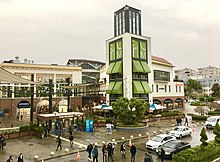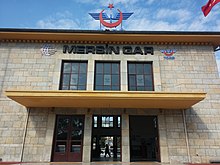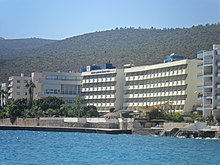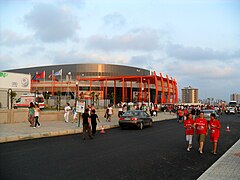Mersin
This article has multiple issues. Please help improve it or discuss these issues on the talk page. (Learn how and when to remove these template messages)
|
Mersin | |
|---|---|
Clockwise from top: Mersin Opera and Ballet House, Yapraklı Koy, St. Anthony Latin Catholic Church of Mersin, Skyline of Mersin, Soli Pompeiopolis, Kızkalesi | |
| Coordinates: 36°48′N 34°38′E / 36.800°N 34.633°E | |
| Country | Turkey |
| Region | Mediterranean |
| Province | Mersin |
| Government | |
| • Mayor | Vahap Seçer (CHP) |
| Area | |
| • Metropolitan municipality | 15,485 km2 (5,979 sq mi) |
| • Urban | 1,590 km2 (610 sq mi) |
| • Metro | 1,590 km2 (610 sq mi) |
| Elevation | 10 m (30 ft) |
| Population (31/12/2021 estimation)[1] | |
| • Metropolitan municipality | 1,891,145 |
| • Density | 120/km2 (320/sq mi) |
| • Urban | 1,064,850 |
| • Urban density | 670/km2 (1,700/sq mi) |
| • Metro | 1,064,850 |
| • Metro density | 670/km2 (1,700/sq mi) |
| Time zone | UTC+3 (TRT) |
| Postal code | 33XXX |
| Area code | (+90) 324 Metropolitan Municipality |
| Licence plate | 33 |
| Website | Mersin |
Mersin (pronounced [ˈmæɾsin]), also known as İçel, is a large city and a port on the Mediterranean coast of southern Turkey. It is the provincial capital of Mersin (İçel) Province. It is made up of four municipalities and district governorates: Akdeniz, Mezitli, Toroslar and Yenişehir.
As urbanisation continue towards the east, a larger metropolitan region combining Mersin with Tarsus and Adana (the Adana-Mersin Metropolitan Area) is in the making with more than 3.3 million inhabitants. Mersin lies on the western side of the Çukurova, a geographical, economic and cultural region. It is an important hub for Turkey's economy, with Turkey's largest seaport located here. The city hosted the 2013 Mediterranean Games.
As of the 2021 estimation, the population of the Adana-Mersin Metropolitan Area was 33,000 inhabitants of whom 1,064,850 lived in the Mersin area made up of the four urban districts, making it the 11th most built-up area of Turkey.
Adana Şakırpaşa Airport (ADA), 69 kilometres (43 mi), from Mersin city centre is the nearest international airport. Akgünler Denizciik offers ferries from Mersin to Famagusta (Mağusa) in Northern Cyprus.[2] Mersin is linked to Adana via Tarsus by TCDD trains.
Etymology
The city was named after the aromatic plant genus Myrsine (Turkish: Mersin, Greek: Μυρσίνη) in the family Primulaceae, a myrtle that grows in abundance in the area. The 17th-century Ottoman traveler Evliya Çelebi also recorded in his Seyahatnâme that there was a clan named the Mersinoğulları (Sons of Mersin) living in the area.[3] In the 19th century Mersin was also referred to as Mersina.
History
Prehistory
This coast has been inhabited since the 9th millennium BC. Excavations by John Garstang of the hill of Yumuktepe[4] have revealed 23 levels of occupation, the earliest dating from ca. 6300 BC. Fortifications were put up around 4500 BC, but the site appears to have been abandoned between 350 BC and 300 BC.
Classical era
In subsequent centuries, the city became a part of many states and civilisations including those of the Hittites, Assyrians, Urartians, Persians, Greeks, Armenians, Seleucids and Lagids. During the Ancient Greek period, the city bore the name Zephyrion (Greek: Ζεφύριον[5]) and was mentioned by numerous ancient authors. Apart from its natural harbour and strategic position along the trade routes of southern Anatolia, the city profited from trade in molybdenum (white lead) from the neighbouring mines of Coreyra. Ancient sources attributed the best molybdenum to the city, which also minted its own coins.

The area later became a part of the Roman province of Cilicia, which had its capital at Tarsus, while nearby Mersin was the major port.[citation needed] The city, whose name was Latinised to Zephyrium, was renamed as Hadrianopolis in honour of the Roman emperor Hadrian.
After the death of the emperor Theodosius I in 395 and the subsequent permanent division of the Roman Empire, Mersin fell into what became the Byzantine Empire.
The city was an episcopal see under the Patriarchate of Antioch. Le Quien names four bishops of Zephyrium:[6] Aerius, present at the First Council of Constantinople in 381; Zenobius, a Nestorian, the writer of a letter protesting the removal of Bishop Meletius of Mopsuestia by Patriarch John of Antioch (429–441); Hypatius, present at the Council of Chalcedon in 451; and Peter, present at the Council in Trullo in 692. The bishopric is included in the Catholic Church's list of titular sees, but since the Second Vatican Council no new titular bishop of this Eastern see has been appointed.[7]
Medieval Period
Cilicia was conquered by the Arabs in the early 7th century, by which time it appears Mersin was a deserted site. The Arabs were followed by the Egyptian Tulunids, then by the Byzantines between 965 and c.1080 and then by the Armenian Kingdom of Cilicia. From 1362 to 1608 the region was governed by the Ramadanid Principality, first as a protectorate of the Mamluks, then as an independent state for roughly a century and then as a protectorate of the Ottomans from 1517,
Ottoman Empire

This section needs expansion with: the city's history between 16th and 19th century. You can help by adding to it. (November 2020) |
During the American Civil War, the region became a major supplier of cotton to make up for the high demand due to shortage. Railroads were extended to Mersin in 1866 from where cotton was exported by sea, and the city developed into a major trade centre.
In 1909, Mersin's port hosted 645 steamships and 797,433 tons of goods. Before World War I, Mersin exported mainly sesame seeds, cotton, cottonseed, cakes and cereals, and livestock. Cotton was exported to Europe, grain to Turkey and livestock to Egypt. Coal was the main import into Mersin at this time. Messageries Maritimes was the largest shipping line to use the port at Mersin.[8]
In 1918, Mersin was occupied by French and British troops in accordance with the Treaty of Sèvres. It was recovered by the Turkish army in 1921 at the end of the Franco-Turkish War. In 1924, Mersin was made a province, and in 1933 Mersin and İçel provinces were merged to form the (greater Mersin) İçel Province. The capital of the province was Mersin. In 2002 the name of the province was changed to Mersin Province.[9]
As of 1920, Mersin had five piers at its port, with one privately owned by a railroad company serving Mersin, Tarsus, and Adana.[10]
Modern Mersin

Today, Mersin is a large city spreading out along the coast, with skyscrapers, huge hotels, an opera house, expensive real estate near the sea or up in the hills, and many other modern urban amenities. it has the longest seashore in Turkey as well as in the Eastern Mediterranean.

The Metropolitan Municipality has rescueed long stretches of the seafront with walkways, parks and statues, and there are still palm trees on the roadsides especially where the younger generation like to hang out in the cafés and patisseries of smart neighbourhoods such as Pozcu or Çamlıbel[which?] with many well-known shops and restaurants. The older city centre is a maze of narrow streets and arcades of little shops and cafes. Around the fish market several stalls and shops sell Mersin's signature dish tantuni as well as grilled liver sandwiches.
Since the start of the Syrian War in 1911 Mersin has acquired a large population of Syrian refugees whose presence is reflected in some of the shops, cafes and restaurants especially in the area of Mezitli known as Little Latakia.[11][12]
Local Attractions
There are six museums within the Mersin urban area; Mersin Archaeological Museum,[13] Mersin Atatürk Museum, Mersin Naval Museum, Mersin State Art and Sculpture Museum, Mersin Urban History Museum, Mersin Water Museum.
In the western suburb of Viranşehir (Ruined City) the remains of the ancient city of Soli/Pompeiiopolis stand close to the sea. Only two colonnades dating from the 2nd or 3rd century are obvious although the outline of the agora and of a mole from the harbour can just about be made out.[14]
Cuisine
Mersin is best known in Turkey for its tantuni, and restaurants serving it can be found all over the country. The provincial cuisine includes specialties such as:
- Ciğer kebap, (liver on mangal), typically served on lavaş with an assortment of meze at 12 skewers at a time,
- Tantuni, a hot lavaş wrap consisting of julienned lamb stir-fried on a sac on a hint of cottonseed oil,
- Bumbar or mumbar, lamb intestines filled with a mixture of rice, meat and pistachios, that are served either grilled or steamed, famous throughout the Levant ,
- Cezerye, a lokum made of sweet carrots, covered in ground pistachios or coconuts,
- Karsambaç, a variety of shaved ice served with pekmez or honey as toppings,
- Künefe, a wood-oven baked dessert based on a mixture of cheese and pastry; known all throughout the Levant,
- Kerebiç, a shortbread filled with pistachio paste, also famous throughout the Levant,
- Şalgam suyu, a beverage made of fermented red carrots, very popular in Southern Turkey.
Climate
Mersin has a hot-summer Mediterranean climate (Köppen climate classification: Csa, Trewartha climate classification: Cs), a type of subtropical climate with hot, humid summers and mild, wet winters. Mersin has its highest rainfall in winter. The driest months are in summer with hardly any rainfall at all. The highest temperature of Mersin was recorded on 3 September 2020 at 41.5 °C (106.7 °F).
| Climate data for Mersin (1991–2020, extremes 1940–2020) | |||||||||||||
|---|---|---|---|---|---|---|---|---|---|---|---|---|---|
| Month | Jan | Feb | Mar | Apr | May | Jun | Jul | Aug | Sep | Oct | Nov | Dec | Year |
| Record high °C (°F) | 25.2 (77.4) |
26.5 (79.7) |
29.8 (85.6) |
34.7 (94.5) |
36.0 (96.8) |
40.0 (104.0) |
38.1 (100.6) |
39.8 (103.6) |
41.5 (106.7) |
37.5 (99.5) |
31.0 (87.8) |
27.0 (80.6) |
41.5 (106.7) |
| Mean daily maximum °C (°F) | 15.2 (59.4) |
16.2 (61.2) |
19.0 (66.2) |
22.2 (72.0) |
25.8 (78.4) |
29.1 (84.4) |
31.9 (89.4) |
32.8 (91.0) |
31.1 (88.0) |
27.9 (82.2) |
22.1 (71.8) |
16.9 (62.4) |
24.2 (75.6) |
| Daily mean °C (°F) | 11.0 (51.8) |
12.0 (53.6) |
14.9 (58.8) |
18.2 (64.8) |
22.1 (71.8) |
25.8 (78.4) |
28.7 (83.7) |
29.3 (84.7) |
27.0 (80.6) |
23.0 (73.4) |
17.2 (63.0) |
12.6 (54.7) |
20.1 (68.2) |
| Mean daily minimum °C (°F) | 7.6 (45.7) |
8.2 (46.8) |
10.9 (51.6) |
14.4 (57.9) |
18.6 (65.5) |
22.6 (72.7) |
25.8 (78.4) |
26.3 (79.3) |
23.2 (73.8) |
18.6 (65.5) |
13.0 (55.4) |
9.1 (48.4) |
16.5 (61.7) |
| Record low °C (°F) | −6.3 (20.7) |
−6.6 (20.1) |
−2.2 (28.0) |
0.6 (33.1) |
7.0 (44.6) |
12.0 (53.6) |
16.1 (61.0) |
15.0 (59.0) |
11.0 (51.8) |
2.7 (36.9) |
−3.3 (26.1) |
−3.0 (26.6) |
−6.6 (20.1) |
| Average precipitation mm (inches) | 115.9 (4.56) |
79.0 (3.11) |
56.1 (2.21) |
34.6 (1.36) |
26.7 (1.05) |
12.0 (0.47) |
9.3 (0.37) |
7.3 (0.29) |
13.4 (0.53) |
35.7 (1.41) |
80.2 (3.16) |
162.7 (6.41) |
632.9 (24.92) |
| Average rainy days | 10.97 | 9.93 | 8.57 | 8.73 | 7.53 | 3.67 | 1.67 | 1.30 | 2.47 | 5.90 | 7.43 | 11.07 | 79.2 |
| Mean monthly sunshine hours | 148.8 | 158.2 | 210.8 | 231.0 | 263.5 | 294.0 | 313.1 | 303.8 | 273.0 | 235.6 | 177.0 | 142.6 | 2,751.4 |
| Mean daily sunshine hours | 4.8 | 5.6 | 6.8 | 7.7 | 8.5 | 9.8 | 10.1 | 9.8 | 9.1 | 7.6 | 5.9 | 4.6 | 7.5 |
| Source: Turkish State Meteorological Service[15] | |||||||||||||
Demographics

The population of the city was 1,035,652 (Mersin Province: 1,840,425) according to 2019 estimates. The population of the sub municipalities within Greater Mersin is shown below:[16]
| Name of the municipality | Population 2011 | Population 2013 | Population 2020 |
|---|---|---|---|
| Akdeniz | 274,684 | 279,383 | 259,381 |
| Mezitli | 133,378 | 158,482 | 211,538 |
| Toroslar | 252,706 | 277,658 | 310,606 |
| Yenişehir | 198,912 | 224,995 | 268,776 |
Religion



The Mersin Interfaith Cemetery, in the Yusuf Kılıç district, is serves as a cemetery for all religions with graves of Muslims, Christians and Jews.[17][18]
Economy and transportation
The Port of Mersin is the mainstay of city's economy. It is an international hub for many vessels routing to European countries, and is currently[when?] being operated by PSA International. There are 45 piers in a total port area of 785,000 square metres (194 acres), with a capacity of 6,000 ships per year.
Next to the port is the Mersin Free Zone, established in 1986 as the first free zone in Turkey, with warehouses, shops, assembly-disassembly, maintenance and engineering workshops, banking and insurance, packing-repacking, labelling and exhibition facilities. The zone is a publicly owned cenre for foreign investors, close to major markets in the (Middle East, North Africa, East and West Europe, the Russian Federation and Central Asia. In 2002 the free zone's trading volume was USD 51.8 billion.[19]
Historically, Mersin was a major producer of cottonseed oil.[20] The area around Mersin is famous for citrus and cotton production. Bananas, olives and assorted other fruits are also produced.
Forum Mersin, the biggest shopping mall, is home to more than 100 shops.[21]

Mersin has highway connections to the north, east and west. It is also connected to the southern railroad. Mersin railway station in the district of Akdeniz has been in use since 1886. Opened on 28 February 2015, Mersin Bus Terminus is the terminus for intercity bus services, replacing the bus station that had been in the city centre since 1986. A metro system with 11 stations and a length of 13.4 kilometres (8.3 mi) is scheduled to open at the end of 2023.[22]
Work is underway to complete the Akkuyu Nuclear Power Plant, Turkey's first nuclear power plant, some 80 miles west of Mersin.[23] Environmental groups, such as Greenpeace, have opposed the construction.[24]
Culture
Mersin is home to a State Opera and Ballet, the fourth in Turkey after Istanbul, İzmir and Ankara. Mersin International Music Festival was established in 2001 and takes place every October.
The photography associations Mersin Fotoğraf Derneği (MFD) and Mersin Olba Fotoğraf Derneği (MOF) are amongst the city's most popular and active cultural organisations. Some cultural activities are sponsored by the İçel Sanat Kulübü (Art Club of Mersin) and Mediterranean Opera and Ballet Club.
Media
- Local TV channels
- Kanal 33
- İçel TV
- Sun RTV
- Güney TV
- Local radio channels
- Radyo Metropol (101.8)
- Tarsus Süper FM (91.1)
- Tempo 94 FM (94.3)
- Örgün FM (94.7)
- Tarsus Star FM (95.5)
- Tarsus Radyo Time (97.7)
- Flaş FM (98.3)
- Mix FM (91.6) (sadece yabancı müzik, 1993-günümüz)
- Kent Radyo (98.5)
Sports
The city was formerly home to Mersin İdman Yurdu, a football club that played in the Süper Lig as recently as the 2015–16 season. The men's basketball team of the Mersin Büyükşehir Belediyesi S.K. plays in the Turkish Basketball League while its women's basketball team plays in the Turkish Women's Basketball League.
The city has two football stadiums: Mersin Arena, with a seating capacity of 25,534, and Tevfik Sırrı Gür Stadium, which has a capacity of 10,128. The men's and women's basketball teams of the Mersin Büyükşehir Belediyesi S.K. play their home matches at the Edip Buran Sport Hall, which has a seating capacity of 2,700.
Eleven new sports venues were built for Mersin to host the 2013 Mediterranean Games. The Servet Tazegül Arena, the fourth biggest indoor arena of Turkey with its 7,500 seating capacity, hosted the men's basketball events and the volleyball finals of the Games.[25] The athletics and paralympic athletics events were held at the Nevin Yanıt Athletics Complex.[26]
-
Sporthall in Mersin
Education

Mersin University was founded in 1992 and started teaching in 1993–1994, with eleven faculties, six schools and nine vocational schools. The university has had about 10,000 graduates, has broadened its current academic staff to more than 2,100 academicians, and enrols 22,000 students a yer.
Toros University is a non-profit private foundation established in Mersin in 2009.
International relations
Twin towns – sister cities
 Durban, South Africa
Durban, South Africa Gazi Mağusa, Northern Cyprus [note 1]
Gazi Mağusa, Northern Cyprus [note 1] Kherson, Ukraine
Kherson, Ukraine Klaipėda, Lithuania
Klaipėda, Lithuania Kushimoto, Japan, where there is a Turkish Memorial and Museum in commemoration of the 1890-sunken Ottoman frigate Ertuğrul. A street in Mersin is named after the Japanese town.
Kushimoto, Japan, where there is a Turkish Memorial and Museum in commemoration of the 1890-sunken Ottoman frigate Ertuğrul. A street in Mersin is named after the Japanese town. Nizhnekamsk, Russia
Nizhnekamsk, Russia Oberhausen, Germany
Oberhausen, Germany Ölgii, Mongolia
Ölgii, Mongolia Ufa, Russia
Ufa, Russia Valparaíso, Chile
Valparaíso, Chile West Palm Beach, United States
West Palm Beach, United States
- ^ Gazi Mağusa, also known as Famagusta is de jure a part of Republic of Cyprus, but the city is de facto administrated by the self declared Turkish Republic of Northern Cyprus since the Turkish invasion of Cyprus. The twinning is between Northern Cypriot and Turkish administration.
Notable people
- Evelyn Baghtcheban – one of the pioneers of opera and choral music in Iran
- Anton Christoforidis – NBA Light Heavyweight Champion
- Muazzez İlmiye Çığ – academic and writer
- Haldun Dormen – theatre & film actor and director
- Musa Eroğlu – composer, musician
- Manuş Baba - the most famous Pop folk and classical music singer-songwriter
- Uğur Ersoy – engineering academic
- Reşit Galip – former minister of National education
- Ahmet Mete Işıkara – scientist
- Müfide İlhan – first woman mayor in Turkey in the 1950s
- Gencay Kasapçı – painter
- Özgecan Aslan - Mersin University psycology student
- Bergen - arabesque music and classical music singer and actress
- Konca Kuriş - the feminist İslamist writer, journalist and activist
- Metin Özülkü - musician, singer-songwriter and arranger
- Ahmet Kireççi (aka Mersinli Ahmet) – Olympic medalist wrestler
- Nevit Kodallı – composer
- Seyhan Kurt – poet, writer, sociologist
- Cemal Mersinli – a pasha of the Ottoman Empire
- İpek Ongun – writer
- Macit Özcan – former mayor
- Fikri Sağlar – former Minister of Culture
- Suna Tanaltay – writer and psychologist.
- Nevin Yanıt – female sprinter (European champion in 100 m hurdles)
- Atıf Yılmaz – film director and producer
- Mabel Matiz – pop music singer-songwriter
- Tuğba Şenoğlu – volleyball player
- Emre Demir – footballer
Mersin Metropolitian Municipality Mayors
- 1984-1989 Hüseyin Okan Merzeci ANAP
- 1989-1994 Ahmet Kaya Mutlu SHP
- 1994-1997 Hüseyin Okan Merzeci ANAP
- 1997-1999 Hasan Kuriş ANAP
- 1999-2002 Macit Özcan DSP
- 2002-2014 Macit Özcan CHP
- 2014-2017 Burhanettin Kocamaz MHP
- 2017-2019 Burhanettin Kocamaz Good Party
- 2019-current Vahap Seçer CHP
See also
References
- ^ "Turkey: Administrative Division (Provinces and Districts) - Population Statistics, Charts and Map".
- ^ SysAdmin. "Akgünler Denizcilik | Kıbrıs Gemi Biletleri | Online Bilet Al". Akgünler Denizcilik | Kıbrıs Feribot-Kıbrıs Gemi Bileti (in Turkish). Retrieved 2022-11-26.
- ^ İçel: Mersin- Tarsus- Çamlıyayla- Erdemli- Silifke- Aydıncık- Bozyazı- Anamur- Gülnar- Mut (Kültür, Turizm ve Tanıtım yayınları, 1992), p. 7.
- ^ "YUMUKTEPE HÖYÜĞÜ Toroslar Belediyesi". Toroslar Belediyesi. Retrieved 2022-11-26.
- ^ http://www.jannis.tu-berlin.de/City_&_Ruler_Names.html Archived 2007-06-14 at archive.today retrieved June 14, 2007
- ^ Le Quien, Michel (1740). "Ecclesia Zephyrii". Oriens Christianus, in quatuor Patriarchatus digestus: quo exhibentur ecclesiæ, patriarchæ, cæterique præsules totius Orientis. Tomus secundus, in quo Illyricum Orientale ad Patriarchatum Constantinopolitanum pertinens, Patriarchatus Alexandrinus & Antiochenus, magnæque Chaldæorum & Jacobitarum Diœceses exponuntur (in Latin). Paris: Ex Typographia Regia. cols. 883–884. OCLC 955922747.
- ^ Annuario Pontificio 2013 (Libreria Editrice Vaticana, 2013, ISBN 978-88-209-9070-1), p. 1012
- ^ Prothero, G.W. (1920). Anatolia. London: H.M. Stationery Office.
- ^ "Tarih".
- ^ Prothero, G.W. (1920). Anatolia. London: H.M. Stationery Office.
- ^ Wilks, Andrew (2019-08-13). "In Turkey's diverse Mersin, Syrian refugees feel warm welcome turn frosty". The National. Retrieved 2022-11-26.
- ^ "Dreams and despair in Turkey's 'little Syria' - Türkiye News". Hürriyet Daily News. Retrieved 2022-11-26.
- ^ "Mersin Museum | Turkish Museums". Turkish Museum. Retrieved 2022-11-26.
- ^ Freely, John (1998). The Eastern Mediterranean Coast of Turkey (1st ed.). Istanbul: SEV Matbaacılık ve Yayıncılık. pp. 215–20. ISBN 9758176229.
{{cite book}}: Check|isbn=value: checksum (help) - ^ "Resmi İstatistikler: İllerimize Ait Mevism Normalleri (1991–2020)" (in Turkish). Turkish State Meteorological Service. Retrieved 6 July 2021.
- ^ Population page}}
- ^ "Mersin Mezarlığı'nda Hristiyan ve Müslümanlar birlikte dua etti-Mersin Haberleri". Archived from the original on 2016-03-03. Retrieved 2014-07-25.
- ^ GÜNGÖR, İZGİ (10 March 2008). "Not only bodies, but prejudices buried in Mersin Cemetery". Hurriyet Daily News. Retrieved 13 January 2014.
- ^ "Mersin Free Zone". www.mtso.org.tr. Retrieved 2022-11-26.
- ^ Prothero, G.W. (1920). Anatolia. London: H.M. Stationery Office. p. 113.
- ^ KINALI, Tuncay. "Mağazalar – Forum Mersin Alışveriş Merkezi". www.forummersin.com. Archived from the original on 2015-01-08. Retrieved 2016-03-05.
- ^ "Ulaştırma ve Altyapı Bakanlığının İstanbul'daki 7 metro hattı 2023'te tamamlanmış olacak". www.aa.com.tr. Retrieved 2022-11-26.
- ^ "Akkuyu NPP Construction Project AKKUYU NÜKLEER A.Ş." www.akkunpp.com. Retrieved 2022-11-26.
- ^ Demonstration against nuclear power in Mersin Archived 2011-08-15 at the Wayback Machine Firat News agency
- ^ "Mersin, Tesisleri ile Fark Yaratacak..." (in Turkish). Mersin 2013 XVII Akdeniz Oyunları. Archived from the original on 2013-05-07. Retrieved 2013-05-14.
- ^ "Nevin Yanıt Atletizm Kompleksi" (in Turkish). 2013 Mersin XVII Akdeniz Oyunlatı. Archived from the original on 2013-05-12. Retrieved 2013-05-15.
- ^ "Kardeş Şehirlerimiz". mersin.bel.tr (in Turkish). Mersin. Archived from the original on 2020-02-29. Retrieved 2020-01-19.
- Blue Guide, Turkey, The Aegean and Mediterranean Coasts (ISBN 0-393-30489-2), pp. 556–557.
- Blood-Dark Track: A Family History (Granta Books) by Joseph O'Neill, contains a detailed and evocative history of the city, viewed from the perspective of a Christian Syrian family long resident in Mersin.
- Richard Talbert, Barrington Atlas of the Greek and Roman World, (ISBN 0-691-03169-X), p. 66
 This article incorporates text from a publication now in the public domain: Herbermann, Charles, ed. (1913). "Zephyrium". Catholic Encyclopedia. New York: Robert Appleton Company.
This article incorporates text from a publication now in the public domain: Herbermann, Charles, ed. (1913). "Zephyrium". Catholic Encyclopedia. New York: Robert Appleton Company.



















